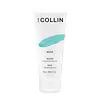What's inside
What's inside
 Key Ingredients
Key Ingredients

 Benefits
Benefits

 Concerns
Concerns

 Ingredients Side-by-side
Ingredients Side-by-side

Water
Skin ConditioningButyrospermum Parkii Butter
Skin ConditioningC15-19 Alkane
SolventGlycerin
HumectantC10-18 Triglycerides
EmollientNiacinamide
SmoothingCaprylic/Capric Triglyceride
MaskingC12-16 Alcohols
EmollientPropanediol
SolventCetyl Alcohol
EmollientHydrogenated Lecithin
EmulsifyingPalmitic Acid
EmollientPanthenol
Skin ConditioningMauritia Flexuosa Fruit Oil
Skin ConditioningYeast Extract
Skin ConditioningCaprylhydroxamic Acid
Soy Amino Acids
Skin ConditioningMyrciaria Dubia Fruit Extract
Skin ConditioningAsparagopsis Armata Extract
Skin ProtectingAscophyllum Nodosum Extract
Skin ConditioningRosmarinus Officinalis Leaf Extract
AntimicrobialSodium Hyaluronate
HumectantGlucomannan
Skin ConditioningTocopherol
AntioxidantEthylhexyl Palmitate
Emollient1,2-Hexanediol
Skin ConditioningStearyl Alcohol
EmollientTitanium Dioxide
Cosmetic ColorantCarbomer
Emulsion StabilisingXanthan Gum
EmulsifyingParfum
MaskingSorbitol
HumectantButylene Glycol
HumectantTriethanolamine
BufferingSclerotium Gum
Emulsion StabilisingLecithin
EmollientPullulan
Trihydroxystearin
Skin ConditioningCI 15985
Cosmetic ColorantSilica
AbrasiveWater, Butyrospermum Parkii Butter, C15-19 Alkane, Glycerin, C10-18 Triglycerides, Niacinamide, Caprylic/Capric Triglyceride, C12-16 Alcohols, Propanediol, Cetyl Alcohol, Hydrogenated Lecithin, Palmitic Acid, Panthenol, Mauritia Flexuosa Fruit Oil, Yeast Extract, Caprylhydroxamic Acid, Soy Amino Acids, Myrciaria Dubia Fruit Extract, Asparagopsis Armata Extract, Ascophyllum Nodosum Extract, Rosmarinus Officinalis Leaf Extract, Sodium Hyaluronate, Glucomannan, Tocopherol, Ethylhexyl Palmitate, 1,2-Hexanediol, Stearyl Alcohol, Titanium Dioxide, Carbomer, Xanthan Gum, Parfum, Sorbitol, Butylene Glycol, Triethanolamine, Sclerotium Gum, Lecithin, Pullulan, Trihydroxystearin, CI 15985, Silica
Water
Skin ConditioningGlycerin
HumectantDipropylene Glycol
Humectant1,2-Hexanediol
Skin ConditioningPanthenol
Skin ConditioningHydrogenated Poly(C6-14 Olefin)
EmollientDicaprylyl Carbonate
EmollientBetaine
HumectantMethyl Trimethicone
Skin ConditioningCeramide NP
Skin ConditioningSodium Stearoyl Glutamate
CleansingPolyglyceryl-10 Stearate
Skin ConditioningAllantoin
Skin ConditioningEthylhexylglycerin
Skin ConditioningCholesterol
EmollientPelargonium Graveolens Flower Oil
MaskingOlea Europaea Fruit Oil
MaskingCitrus Aurantium Bergamia Fruit Oil
MaskingCetearyl Alcohol
EmollientBehenyl Alcohol
EmollientAcrylates/C10-30 Alkyl Acrylate Crosspolymer
Emulsion StabilisingHydrogenated Lecithin
EmulsifyingTromethamine
BufferingGlyceryl Stearate Se
EmulsifyingSalvia Officinalis Oil
MaskingSodium Phytate
Tocopherol
AntioxidantCI 19140
Cosmetic ColorantWater, Glycerin, Dipropylene Glycol, 1,2-Hexanediol, Panthenol, Hydrogenated Poly(C6-14 Olefin), Dicaprylyl Carbonate, Betaine, Methyl Trimethicone, Ceramide NP, Sodium Stearoyl Glutamate, Polyglyceryl-10 Stearate, Allantoin, Ethylhexylglycerin, Cholesterol, Pelargonium Graveolens Flower Oil, Olea Europaea Fruit Oil, Citrus Aurantium Bergamia Fruit Oil, Cetearyl Alcohol, Behenyl Alcohol, Acrylates/C10-30 Alkyl Acrylate Crosspolymer, Hydrogenated Lecithin, Tromethamine, Glyceryl Stearate Se, Salvia Officinalis Oil, Sodium Phytate, Tocopherol, CI 19140
 Reviews
Reviews

Ingredients Explained
These ingredients are found in both products.
Ingredients higher up in an ingredient list are typically present in a larger amount.
1,2-Hexanediol is a synthetic liquid and another multi-functional powerhouse.
It is a:
- Humectant, drawing moisture into the skin
- Emollient, helping to soften skin
- Solvent, dispersing and stabilizing formulas
- Preservative booster, enhancing the antimicrobial activity of other preservatives
Glycerin is already naturally found in your skin. It helps moisturize and protect your skin.
A study from 2016 found glycerin to be more effective as a humectant than AHAs and hyaluronic acid.
As a humectant, it helps the skin stay hydrated by pulling moisture to your skin. The low molecular weight of glycerin allows it to pull moisture into the deeper layers of your skin.
Hydrated skin improves your skin barrier; Your skin barrier helps protect against irritants and bacteria.
Glycerin has also been found to have antimicrobial and antiviral properties. Due to these properties, glycerin is often used in wound and burn treatments.
In cosmetics, glycerin is usually derived from plants such as soybean or palm. However, it can also be sourced from animals, such as tallow or animal fat.
This ingredient is organic, colorless, odorless, and non-toxic.
Glycerin is the name for this ingredient in American English. British English uses Glycerol/Glycerine.
Learn more about GlycerinHydrogenated Lecithin is created from the hydrogenation of lecithin (a group of phospholipids). Hydrogenation is a chemical reaction between hydrogen and another element.
This ingredient is an emollient and emulsifier. As an emollient, it helps soften skin by trapping moisture within. As an emulsifier, it prevents oil and water ingredients from separating.
Panthenol is a common ingredient that helps hydrate and soothe the skin. It is found naturally in our skin and hair.
There are two forms of panthenol: D and L.
D-panthenol is also known as dexpanthenol. Most cosmetics use dexpanthenol or a mixture of D and L-panthenol.
Panthenol is famous due to its ability to go deeper into the skin's layers. Using this ingredient has numerous pros (and no cons):
Like hyaluronic acid, panthenol is a humectant. Humectants are able to bind and hold large amounts of water to keep skin hydrated.
This ingredient works well for wound healing. It works by increasing tissue in the wound and helps close open wounds.
Once oxidized, panthenol converts to pantothenic acid. Panthothenic acid is found in all living cells.
This ingredient is also referred to as pro-vitamin B5.
Learn more about PanthenolTocopherol (also known as Vitamin E) is a common antioxidant used to help protect the skin from free-radicals and strengthen the skin barrier. It's also fat soluble - this means our skin is great at absorbing it.
Vitamin E also helps keep your natural skin lipids healthy. Your lipid skin barrier naturally consists of lipids, ceramides, and fatty acids. Vitamin E offers extra protection for your skin’s lipid barrier, keeping your skin healthy and nourished.
Another benefit is a bit of UV protection. Vitamin E helps reduce the damage caused by UVB rays. (It should not replace your sunscreen). Combining it with Vitamin C can decrease sunburned cells and hyperpigmentation after UV exposure.
You might have noticed Vitamin E + C often paired together. This is because it is great at stabilizing Vitamin C. Using the two together helps increase the effectiveness of both ingredients.
There are often claims that Vitamin E can reduce/prevent scarring, but these claims haven't been confirmed by scientific research.
Learn more about TocopherolWater. It's the most common cosmetic ingredient of all. You'll usually see it at the top of ingredient lists, meaning that it makes up the largest part of the product.
So why is it so popular? Water most often acts as a solvent - this means that it helps dissolve other ingredients into the formulation.
You'll also recognize water as that liquid we all need to stay alive. If you see this, drink a glass of water. Stay hydrated!
Learn more about Water